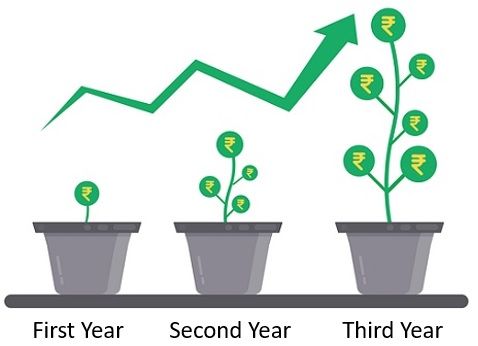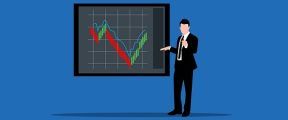 Intraday Trading is one in which the purchasing and selling of stocks take place within the same day before the market closes.
Intraday Trading is one in which the purchasing and selling of stocks take place within the same day before the market closes.
As against, Delivery Trading is the type of trading in which the investor buys shares one day and sells the same on a later date after holding them for some days. This means that the investor purchases shares and then holds them for a certain period. Thereafter, on the delivery of the stocks, it appears in his/her Demat Account. Investors can sell the stocks whenever they wish to do so.
Both intraday and delivery trading are two ways of trading in the stock market.
It is often said that the stock market earns you great returns when you invest your money for a long period. However, investors can also earn good returns in the short term when the investors keep an eye on market trends and indicators.
So, in this post, we are going to educate you on the difference between intraday and delivery trading.
Content: Intraday Vs Delivery Trading
Comparison Chart
| Basis for Comparison | Intraday Trading | Delivery Trading |
|---|---|---|
| Meaning | When the investor is buying and selling the stocks on the same trading day, they are performing intraday trading. | Delivery trading is one in which the investor buys the stocks on a trading day and sells them at a later date. |
| Motive | Quick profit | Invest and grow money |
| Time constraint | Yes | No |
| Best for | Those who are experts or professionals in the field of trading | Everyone with little knowledge of stock market. |
| DP charges | Not imposed | Imposed in case of selling of the stocks only |
| Risk Factor | High | Comparatively less |
| Time Constraint | Yes, the time constraint is there. | There is no time constraint. |
What is Intraday Trade?
When the purchasing and selling of stocks take place on the same day, it is intraday trading. In short, the execution of both parts of the transactions takes place on the same trading day using online platforms like websites or apps.
Therefore the net holding of the investor will be zero. Furthermore, if the investor does not square off the position by the end of the trading day, the stocks are automatically sold. The stocks are sold at the closing price of the day under the specified brokerage charges.
Investors perform intraday trading with the sole aim of earning profits by keeping a close watch on the movement of market indices, i.e. Nifty and Sensex. People also call it Day Trading.
Points to Note
- The investor can enter and exit the market on the same day.
- If the investor does not close or squares off the open position fifteen minutes before the closing of the market, then the broker may close it automatically against a brokerage.
- For beginning intraday trading, you need to open an online trading account with the stockbroker.
- To carry out intraday trading, the investor needs to select: Product Type – Intraday.
- The stock broker allows a margin of a certain percentage to the investor for carrying out trade.
Example
Suppose the investor buys stocks at 11:00 AM, so the investor has to sell them before the closing of the market. If the Investor fails to sell the stocks before the closing of the market, then the shares are automatically squared off.
Also Read: Difference Between Trading Account and Demat Account
What is Delivery Trade?
When the investor does not sell the stock on the same day on which he has bought them, it is a delivery trade. In short, in such a trade, execution of only one part of the transaction takes place on a trading day. This is because it allows the investor to hold shares for the long term.
As soon as you buy the stocks of any company on a delivery basis, the investor becomes the owner of the shares legally. On the execution of delivery, the stocks appear in the investor’s Demat account. After that, the investor has the right to sell the stocks at any time.
More precisely, when the investor buys stocks, they are transferred to his/her Demat account on Trading + 2 days. In the same way, when the investor sells the stocks, they are debited from the investor’s Demat account on Trading + 2 days.
Points to Note
- In delivery trading, investors hold stocks for a longer period and wait for the right time to cash out and earn substantial returns. Hence, the investor needs to be patient.

- The investor can only sell the stock when he has bought the stock on a particular trading day and then waited for trading plus 2 working days. And when the shares start reflecting on the Demat account of the investor, he can sell them at any time, i.e. be it after 10 days, 10 years or more. This means that investors cannot sell the stocks until are not appearing on the respective Demat account.
- Stockbrokers provide an e-margin facility in case of delivery trading too. However, for availing of the facility of margin, the investors have to pledge the existing stocks in their Demat account. The investor can either withdraw the money received in the form of a margin, or he can invest the same for buying more stocks.
- Brokers charge interest on margin facility at a high rate.
Also Read: Difference Between Full-Service Broker and Discount Broker
Key Differences Between Intraday and Delivery Trading
The points listed below explain the difference between intraday and delivery trading:
- In an Intraday trade, as the name signifies, stocks bought in a day are sold by the day ends. This means that the investor sells the stocks prior to the closing of the market for the day. Now you must be wondering –
What if the shares are not sold by the end of the day?
Well, in that case, the shares are squared off automatically at the closing price. Oppositely, in the delivery trade, the investor holds the stock for some time after buying them. He/She does so for earning good returns on it over time.
- In Intraday Trading, the investor performs trade with the aim of making a profit. Conversely, in delivery trading, the investor invests in stocks with the aim of growing money over time and reaping high returns.
- In Intraday trade, there is always a time constraint for selling the stocks within the same day. As against, in the case of delivery trading, the investor can hold the stocks as long as he wishes to do so. This is because there is no time constraint to sell them.
- While Intraday trading is best for professionals, as they are highly risky and it requires strong analysis to perform the trading wisely. However, even a person with little knowledge of the stock market can make money from delivery trading.
- In the case of intraday, the risk factor is high, but it is a one-day affair too. Whereas in the case of delivery trading, the risk factor is comparatively less. But at the same time, as the investor holds positions for a long period, the risk will always be there.
- In Intraday Trading, you can take leverage price advantage during the trading day. However, the investor needs to be careful to plan and execute entry and exit at the right time. Also, one must be attentive to the price movements throughout the trading hours and use charts. But, with delivery trading, the investor can buy the stocks once and then sit and relax for as long as he wants, as there is no time constraint. He can sell the stocks any time after the execution of delivery.
- Stock Brokers offer high leverage or margin for intraday trading. This means that the investors can buy more shares using the leverage option than the amount present in their account. In case of delivery, the investor must make full payments in advance. That means the settlement of delivery trade takes place in cash. The investor can buy shares only when the account has a sufficient balance.
Conclusion
All in all, both types of trading have their pros and cons. While intraday trading completes within the span of the trading day. They are highly risky, as the investor either earns huge profits out of it or loses it if he chooses the wrong stocks to invest in.
Oppositely, in delivery trading, investors buying the stocks need to keep them for a long period of time to yield good returns. It is a long-term investment, and so the shares grow gradually but often give high returns.






Vivek Rige says
Informative article on difference between intraday and delivery trading.